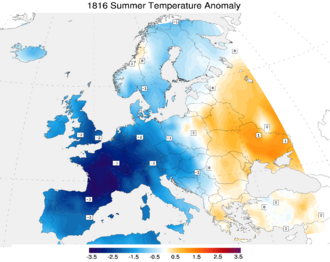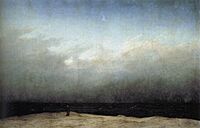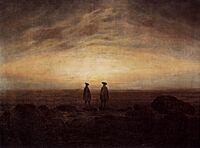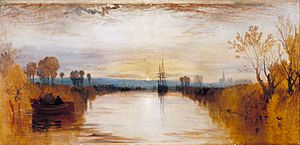Year Without a Summer facts for kids
Quick facts for kids Year Without a Summer |
|
|---|---|

1816 summer temperature anomaly compared with average temperatures from 1971 to 2000
|
|
| Volcano | Mount Tambora |
| Type | Ultra-Plinian |
| Location | Lesser Sunda Islands, Dutch East Indies (now Republic of Indonesia) |
| Impact | Caused a volcanic winter that dropped temperatures by 0.4–0.7°C (or 0.7–1°F) worldwide |
The year 1816 is known as the Year Without a Summer because of very strange weather. Global temperatures dropped by about 0.4 to 0.7 degrees Celsius. Summers in Europe were the coldest ever recorded between 1766 and 2000. This led to huge problems with crops and serious food shortages across the northern part of the world.
Scientists believe this strange weather was mostly caused by a "volcanic winter." This happened because of the massive 1815 eruption of Mount Tambora in April 1815. Mount Tambora is in what is now Indonesia. This eruption was the biggest in at least 1,300 years. It might have been made worse by another eruption in 1814 from Mayon volcano in the Philippines. A huge amount of volcanic ash and gases shot into the air. These particles blocked sunlight, making the whole world cooler.
Countries like Great Britain, Ireland, and France faced tough times. People rioted over food, and famine became common. Europe was also still recovering from the Napoleonic Wars, which made things even harder.
North America also had extreme weather. In the eastern United States, a constant "dry fog" made the sunlight dim. This caused unusual cold and frost all summer long. Crops failed in places like New England, leading to food shortages and money problems. Many families had to leave their homes to find better places to farm. This helped people move westward across the country.
Contents
What Happened During the Year Without a Summer?
The Year Without a Summer was a disaster for farming. One historian called it "the last great food crisis in the Western world." The weird weather of 1816 hit New England, Atlantic Canada, and Western Europe the hardest.
The main reason for the Year Without a Summer was a "volcanic winter." This was caused by the April 1815 eruption of Mount Tambora on Sumbawa island. This eruption was incredibly powerful, ranking as a VEI-7. It shot at least 37 cubic kilometers of rock and ash into the air. It's the most powerful eruption confirmed since then.
Other big volcanic eruptions (VEI-4 or more) happened around this time too:
- An unknown eruption in the southwestern Pacific Ocean in 1808.
- La Soufrière on Saint Vincent in the Caribbean in 1812.
- Awu in the Sangihe Islands, Dutch East Indies in 1812.
- Suwanosejima in the Ryukyu Islands in 1813.
- Mayon in the Philippines in 1814.
These eruptions added a lot of dust to the atmosphere. Temperatures worldwide dropped because this airborne material blocked sunlight high up in the sky. One study from 2012 found that the Tambora eruption caused Earth's average land temperature to drop by about one degree Celsius. The earlier eruptions from 1812–1814 also caused smaller temperature drops.
The Earth was already in a long period of cooling called the Little Ice Age, which started in the 14th century. This period had already caused farming problems in Europe. The Tambora eruption happened near the end of the Little Ice Age, making the natural cooling even worse.
This time also happened during the Dalton Minimum. This was a period from 1790 to 1830 when the sun was less active. May 1816 had the lowest "Wolf number" (a measure of solar activity) ever recorded at that time. Scientists are still learning how changes in the sun's activity affect Earth's climate. So, this link doesn't prove that less solar activity causes global cooling.
How Different Parts of the World Were Affected
Africa
We don't have direct information for the Sahel region, but nearby areas suggest they had more rain than usual. Coastal parts of West Africa probably had less rain. Strong storms hit the South African coast during their winter. A very strong storm with powerful winds and hail hit near Cape Town on July 29–30, 1816. It caused serious damage to ships.
Asia
The monsoon season in China was messed up, leading to huge floods in the Yangtze Valley. In Fort Shuangcheng, reports said fields were ruined by frost. Soldiers even left their posts because of it. Summer snow or mixed rain and snow was reported in places like Jiangxi and Anhui. In Taiwan, snow fell in Hsinchu and Miaoli, and frost hit Changhua. A massive famine in Yunnan helped weaken the ruling Qing dynasty.
In India, the delayed summer monsoon brought late, heavy rains. This made it easier for cholera to spread from the Ganges area in Bengal all the way to Moscow. In Bengal, people reported unusual cold and snow during the winter monsoon.
In Japan, people were still careful after the cold-weather Great Tenmei famine of 1782–1788. The cold damaged crops, but there were no full crop failures. It didn't have a bad effect on the population.
Europe
Because of several volcanic eruptions in the 1810s, crops had been poor for a few years. The Tambora eruption in 1815 was the final blow. Europe was still recovering from the Napoleonic Wars. It suffered from widespread food shortages, leading to its worst famine of the century. Low temperatures and heavy rains caused harvests to fail in Great Britain and Ireland. Famine was common in northern and southwestern Ireland. Wheat, oat, and potato crops all failed.
Food prices shot up across Europe. People didn't know why the problems were happening. Hungry crowds protested in front of grain markets and bakeries. Food riots happened in many European cities. While riots were common during times of hunger, the food riots of 1816 and 1817 were the most violent since the French Revolution.
Between 1816 and 1819, serious typhus epidemics broke out in parts of Europe. This included Ireland, Italy, Switzerland, and Scotland. The famine made these outbreaks worse. More than 65,000 people died as the disease spread from Ireland.
The long-running temperature record for Central England showed 1816 as the eleventh coldest year since 1659. It was also the third coldest summer and the coldest July ever recorded. Widespread flooding of Europe's major rivers is linked to this event, as is frost in August. Hungary even saw snowfall that was brown from volcanic ash. In northern Italy, red snow fell throughout the year.
In western Switzerland, the summers of 1816 and 1817 were so cold that an ice dam formed below a part of the Giétro Glacier. This created a lake. Even though an engineer tried to drain the growing lake, the ice dam broke in June 1818. This caused a terrible flood that killed forty people.
North America
In the spring and summer of 1816, a constant "dry fog" was seen in parts of the eastern United States. The fog made the sunlight red and dim. You could even see sunspots with your bare eyes. Wind or rain didn't clear this "fog." Scientists later called it a "stratospheric sulfate aerosol veil."
The cold weather itself wasn't the biggest problem for people used to long winters. The real hardship came from how the weather affected crops, and thus the supply of food and firewood. The effects were felt most strongly in higher areas, where farming was already tough. In May 1816, frost killed most crops in the higher parts of Massachusetts, New Hampshire, Vermont, and upstate New York. On June 6, snow fell in Albany, New York, and Dennysville, Maine. In Cape May, New Jersey, frost was reported five nights in a row in late June, causing huge crop damage.
Even though fruit and vegetable crops survived in New England, corn didn't grow well. Only about a quarter of it could be used for food, and much of it was moldy and not even good for animal feed. Crop failures in New England, Canada, and parts of Europe caused food prices to rise sharply. In Canada, Quebec ran out of bread and milk. People in Nova Scotia had to boil wild plants for food.
Sarah Snell Bryant, from Cummington, Massachusetts, wrote in her diary: "Weather backward." At the Church Family of Shakers near New Lebanon, New York, Nicholas Bennet wrote in May 1816 that "all was froze" and the hills were "barren like winter." Temperatures dropped below freezing almost every day in May. The ground froze on June 9. On June 12, the Shakers had to replant crops destroyed by the cold. By July 7, it was so cold that all their crops had stopped growing.
A doctor from Salem, Massachusetts, Edward Holyoke, was in Franconia, New Hampshire. He wrote on June 7, "exceedingly cold. Ground frozen hard, and squalls of snow through the day. Icicles 12 inches long in the shade of noon day." After a short break, by August 17, Holyoke noticed a sudden change from summer to winter. By August 21, a small bean and corn crop were killed. "The fields," he wrote, "were as empty and white as October." The Berkshires saw frost again on August 23, as did much of New England and upstate New York.
A Massachusetts historian, William G. Atkins, summed up the disaster: "Severe frosts occurred every month; June 7th and 8th snow fell, and it was so cold that crops were cut down, even freezing the roots ... In the early Autumn when corn was in the milk it was so thoroughly frozen that it never ripened and was scarcely worth harvesting. Breadstuffs were scarce and prices high and the poorer class of people were often in straits for want of food. It must be remembered that the granaries of the great west had not then been opened to us by railroad communication, and people were obliged to rely upon their own resources or upon others in their immediate locality."
In July and August, ice was seen on lakes and rivers as far south as northwestern Pennsylvania. Frost was reported in Virginia on August 20 and 21. Temperatures changed very quickly. They would sometimes go from normal summer highs (up to 35°C or 95°F) to near-freezing in just a few hours. Thomas Jefferson, who had retired to his home at Monticello, had crop failures that put him deeper in debt. On September 13, a Virginia newspaper reported that corn crops would be only one-half to two-thirds of the normal amount. It sadly said that "the cold as well as the drought has nipt the buds of hope." A Norfolk, Virginia, newspaper reported: "It is now the middle of July, and we have not yet had what could properly be called summer. Easterly winds have prevailed for nearly three months past ... the sun during that time has generally been obscured and the sky overcast with clouds; the air has been damp and uncomfortable, and frequently so chilling as to render the fireside a desirable retreat."
Some local farmers managed to grow some crops. But prices for corn and other grains rose sharply. For example, the price of oats went from 12 cents per bushel in 1815 to 92 cents per bushel in 1816. The crop failures were made worse because there weren't good ways to transport food. With few roads or rivers for travel, and no railroads, it was too expensive to bring in food in most parts of the country.
Maryland had brown, bluish, and yellow snowfall in April and May. This was colored by volcanic ash in the air.
South America
A newspaper report from northeastern Brazil was published in the United Kingdom. It said that by February 8, 1817, a very unusual drought had hit the tropical parts of Brazil. This was the area between Pernambuco and Rio de Janeiro. All the streams had dried up, cattle were dying, and people were moving to big rivers to find water. There was great distress, food was scarce, and mills couldn't work. They had no windmills, so no corn could be ground. Ships were sent from Pernambuco to the United States to get flour. The problem was made worse because coastal trade was stopped due to fear of war with Buenos Aires.
How Society Changed
A lot of volcanic ash in the air caused a haze that stayed in the sky for several years after the eruption. This also created rich red colors in sunsets. Paintings from the years before and after the eruption seem to show that these striking reds weren't there before Mount Tambora erupted. Paintings from after the eruption often show darker, moodier scenes, even in sunlight or moonlight. Caspar David Friedrich's The Monk by the Sea (around 1808–1810) and Two Men by the Sea (1817) show this change in mood.
A 2007 study looked at paintings made between 1500 and 1900, especially around big volcanic events. It found a link between volcanic activity and how much red was used in paintings. High levels of ash in the air led to amazing sunsets during this time. These sunsets are shown in the paintings of J. M. W. Turner. They might also explain the yellow tint often seen in his paintings, like Chichester Canal (1828). Similar things were seen after the 1883 eruption of Krakatoa and on the West Coast of the United States after the 1991 eruption of Mount Pinatubo.
The lack of oats to feed horses might have inspired the German inventor Karl Drais. He started looking for new ways to travel without horses. This led to his invention of the draisine and velocipede, which were early versions of the bicycle.
The crop failures of the "Year without a Summer" might have influenced how the Midwestern United States was settled. Thousands of people left New England for western New York and the Northwest Territory. They were looking for better weather, richer soil, and better farming conditions. Indiana became a state in December 1816, and Illinois two years later. One British historian suggested that this move into upstate New York helped make the abolitionist movement strong in that area.
According to historian L. D. Stillwell, Vermont alone lost between 10,000 and 15,000 people in 1816 and 1817. This wiped out seven years of population growth. Among those who left Vermont was the family of Joseph Smith. They moved from Norwich, Vermont, to Palmyra, New York. This move led to a series of events that ended with Smith founding the Church of Jesus Christ of Latter-day Saints.
In June 1816, constant rain during the "wet, unpleasant summer" forced Mary Shelley, Percy Bysshe Shelley, Lord Byron, John William Polidori, and their friends to stay indoors. They were on holiday in Switzerland at Villa Diodati. They read a collection of German ghost stories. Inspired by this, Lord Byron suggested a contest to see who could write the scariest story. This led Shelley to write Frankenstein. Lord Byron wrote "A Fragment", which Polidori later used for his story The Vampyre – an early vampire story that influenced Dracula. Mary Shelley remembered these days inside Villa Diodati fondly. They had many interesting conversations. After listening closely to one, she woke up with the image of Victor Frankenstein kneeling over his monster. This inspired her to write Frankenstein. Lord Byron was inspired to write the poem "Darkness" by one day when "the fowls all went to roost at noon and candles had to be lit as at midnight." The images in the poem are very similar to the conditions of the Year Without a Summer:
I had a dream, which was not all a dream.
The bright sun was extinguish'd, and the stars
Did wander darkling in the eternal space,
Rayless, and pathless, and the icy earth
Swung blind and blackening in the moonless air;
Morn came and went—and came, and brought no day
Justus von Liebig, a chemist who had experienced the famine as a child in Darmstadt, later studied how plants get their food. He then introduced mineral fertilizers.
Similar Events in History
- The Toba catastrophe (a supervolcano eruption).
- Climate problems around 1628–1626 BC, likely from the Minoan eruption of Santorini.
- The Hekla 3 eruption around 1200 BC, which happened around the time of the Bronze Age collapse.
- The Hatepe eruption (also called the Taupō eruption), around AD 180.
- The winter of 536 has been linked to a volcanic eruption, possibly at Krakatoa or Ilopango in El Salvador.
- The Heaven Lake eruption of Paektu Mountain (between modern-day North Korea and China) in 969. This might have played a role in the fall of Balhae.
- The 1257 Samalas eruption of Mount Rinjani on the island of Lombok in 1257.
- The 1452/1453 mystery eruption has been linked to events around the Fall of Constantinople in 1453.
- An eruption of Huaynaputina in Peru caused 1601 to be the coldest year in the Northern Hemisphere for six centuries. This led to the Russian famine of 1601–1603. 1601 had a very cold winter, a cold, frosty, almost non-existent spring, and a cool, cloudy, wet summer.
- An eruption of Laki in Iceland caused hundreds of thousands of deaths across the Northern Hemisphere (over 25,000 in England alone). It also led to one of the coldest winters ever recorded in North America, 1783–1784. Long-term effects included poverty and famine, which may have helped cause the French Revolution in 1789.
- The 1883 eruption of Krakatoa caused average Northern Hemisphere summer temperatures to drop by as much as 1.2°C (2.2°F). One of the wettest rainy seasons in California's recorded history followed in 1883–1884.
- The eruption of Mount Pinatubo in 1991 led to strange weather patterns and temporary cooling in the United States. This was especially true in the Midwest and parts of the Northeast. Every month in 1992, except January and February, was colder than normal. More rain than usual fell across the West Coast of the United States, especially California, during the 1991–1992 and 1992–1993 rainy seasons. The American Midwest had more rain and major flooding during the spring and summer of 1993. This might also have contributed to the historic "Storm of the Century" on the Atlantic Coast in March of that same year.
Images for kids
See also
 In Spanish: Año sin verano para niños
In Spanish: Año sin verano para niños
- 1458 mystery eruption
- Dalton Minimum
- Global cooling
- Little Ice Age
- Tambora culture
- Timeline of volcanism on Earth







